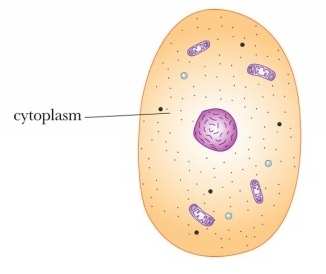

MedFriendly®


Protoplasm
Protoplasm refers to the living content that animals
and vegetable cells are formed of, surrounded by a
cell membrane). A cell is the smallest, most basic
unit of life, that is capable of existing by itself.
Protoplasm is sometimes used as a term term for all
of the materials found inside a cell.
In eukaryotes (organisms whose cells contain
complex structures inside membranes), protoplasm
surrounding the cell nucleus (control center) refers to
cytoplasm, a gel-like substance found inside the cell.
In such cases, the protoplasm inside the nucleus is
referred to as the nucleoplasm.
Protoplasm as cytoplasm.
FEATURED BIOLOGY BOOK: Molecular Biology of the Cell
In prokaryotes (organisms whose cells lack a nucleus), the material inside the cell
membrane is known as bacterial cytoplasm. In Gram negative bacteria (bacteria that do
not retain a certain crystal dye), the area outside the cell membrane but inside the outer
membrane is known as periplasm.
Nowadays, protoplasm is typically divided into cytoplasm and multiple organelles.
Organelles are a name for all of the small bodies in the cell that perform necessary roles
regarding the chemical reactions inside a cell. Examples included the cell nucleus,
mitochondria, and plastids. Mitochondria are rod-shaped bodies that break down simple
substances to provide energy. Plastids are tiny bodies found in plant cells that contain
substances important for the plant to live. The liquid aspect of protoplasm is transparent.
Depending on the functional state of the cell, protoplasm can take a liquidy and slightly
gel-like form (like egg whites), a semi-solid form (like jelly), or a solid form. The more
liquid form is known as a sol.
"Where Medical Information is Easy to Understand"™
Protoplasm was once considered a mysterious
substance but nowadays it is recognized that it is
made of an assortment of small organic and
inorganic molecules. Organic molecules contain
the element, carbon, whereas inorganic molecules
do not. Ninety percent of protoplasm is made up of
inorganic substances such as water, inorganic
salts (e.g., mineral salts such as sodium chloride),
and gases (e.g., oxygen and carbon dioxide.
Organic substances include fat cells, amino acids,
nucleic acids, and polysaccharides (types of
carbohydrates).


Amino acids are a group of chemical substances that form proteins. Nucleic acids are substances
found in all living things that play a major role in the continuation of life. Carbohydrates are a group of
substances present in certain types of foods (such as sugar) that provides the body with energy.
Protoplasm is also made of ions (electrically charged particles), which can be organic or inorganic.
Chemical functions of the cell take place within the protoplasm such as responding to environmental
stimuli. The protoplasm is capable of moving (expanding and contracting) and growing (as the cell
divides). Movement of the protoplasm is referred to as protoplasmic streaming.
Protoplasm is also known as plasmogen. The term, protoplasm, has become relatively unpopular among
biologists these days as the specific substances inside the cell tend to be named individually.
Protoplasm comes from the Greek word "protos" meaning "first" and the Greek word "plasma" meaning
"thing formed." Put the two words together and you have "first thing formed."
The term, protoplasm, was first used by a physiologist (Jan Pukinje) in 1840 when describing the
formative material of animal embryos. A physiologist is someone who studies the functions of human
organisms and their parts. An embryo is a fertilized egg from the time of conception until the 8th week
of pregnancy. A German botanist (plant biologist), Hugo von Mohl, is often credited with being the first
to use the term protoplasm, although this is incorrect as noted above. He did, however, describe
protoplasm as a"tough, slimy, granular, semi-fluid" material inside plant cells, distinguishing it from the
wall and nucleus of the cell and the sap within the vacuoles (sacs in the cytoplasm that are filled with
fluid). Some people state that the term protoplasm originated in 1835 with a zoologist named F lix
Dujardin but he actually referred to it as “sarcode.”
The English biologist, Thomas Huxley, later referred to protoplasm as “the physical basis of life.” He
believed that life resulted from molecules being spread within the protoplasm. Failed attempts were
made to manually reproduce it is the laboratory to study the beginnings of life as protoplasm as it was
traditionally considered responsible for all living processes.














